Launch of new Orion spaceship has NASA flying high
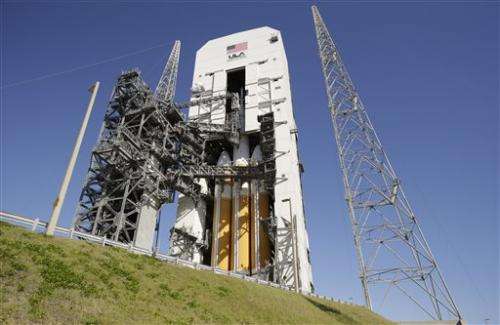
With the imminent debut of its Orion spacecraft, NASA is on a high not felt since the space shuttle days.
Shuttle veterans, in fact, are leading the charge in Thursday morning's two-orbit, 4½-hour test flight, meant to shake out the capsule before astronauts climb aboard—eventually, perhaps, to visit Mars.
"We haven't had this feeling in a while, since the end of the shuttle program," said Mike Sarafin, the lead flight director stationed at Mission Control in Houston. "Launching an American spacecraft from American soil and beginning something new, in this case exploring deep space."
Orion is set to fly farther than any human-rated spacecraft since the Apollo moon program, aiming for a distance of 3,600 miles (5,800 kilometers), more than 14 times higher than the International Space Station.
That peak altitude will provide the necessary momentum for a 20,000-mph (32,200-kph), 4,000-degree entry over the Pacific. Those 11 short minutes to splashdown is what NASA calls the "trial by fire," arguably the most critical part of the entire test flight. The heat shield at Orion's base, at 16.5 feet (5 meters) across, is the largest of its kind ever built.
Navy ships were stationed near the recovery zone off the Mexican Baja coast.
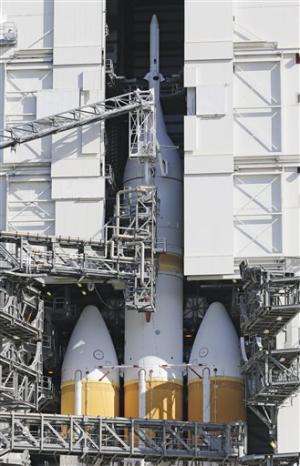
NASA's Orion program manager, Mark Geyer, puts the capsule's inaugural run on a par with the formative steps of Apollo and the space shuttles.
"In the sense that we are beginning a new mission, it is, I think, consistent with ... the beginning of shuttle, the beginning of Apollo," Geyer said.
Noted NASA Administrator Charles Bolden Jr.: "For the first time in more than 40 years, this nation is going to launch a spacecraft intended to carry humans beyond low-Earth orbit. That's a big deal."
Unlike the first space shuttle flight in 1981—helmed by two pilots—Orion will not carry astronauts before 2021.
NASA wants to test the most critical parts of the capsule on this $370 million shakedown cruise, including the heat shield, parachutes and all the sections jettisoned during ascent and entry. The capsule also will travel through the high-radiation Van Allen belts surrounding Earth; engineers want to gauge the effects on the on-board computers.
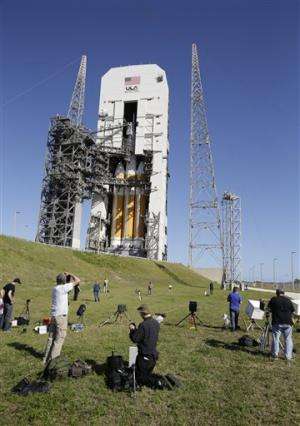
A Delta IV rocket is hoisting Orion this time around. For Orion's next flight, around 2018, the capsule will fly atop the megarocket still in development by NASA—SLS, short for Space Launch System. Only after that will humans climb aboard; NASA hopes to send an Orion crew to an asteroid corralled in lunar orbit in the 2020s and to Mars in the 2030s.
Still fresh in everyone's minds is October's explosion moments after liftoff of a commercial rocket carrying supplies for the International Space Station. No one was on board that flight, either, and no one on the ground was hurt.
Lockheed Martin Corp. is handling the test flight for NASA, much the way NASA has contracted out the development of two manned capsules meant for space station ferry trips.
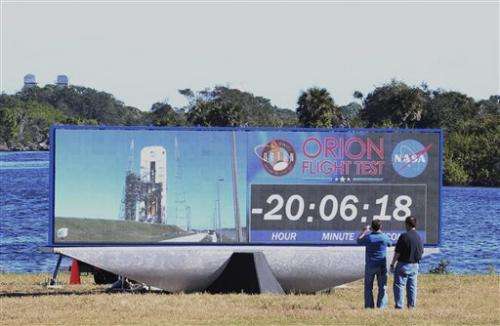
Even so, the shuttle ties run deep.
Sarafin's entire team at Johnson Space Center in Houston is comprised of former shuttle flight controllers. A special VIP, on hand in Mission Control on Thursday, will be Gene Kranz, the legendary flight director of Apollo 11 and 13 fame, and more.
-
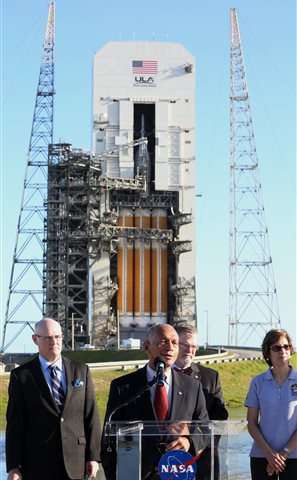
NASA administrator Charles F. Bolden Jr., center, speaks at a news conference at the Cape Canaveral Air Force Station, Wednesday, Dec. 3, 2014, in Cape Canaveral, Fla. Orion is scheduled to lift off Thursday, Dec. 4, 2014, on a United Launch Alliance Delta 4-heavy rocket on its first unmanned orbital test flight. (AP Photo/Marta Lavandier) -
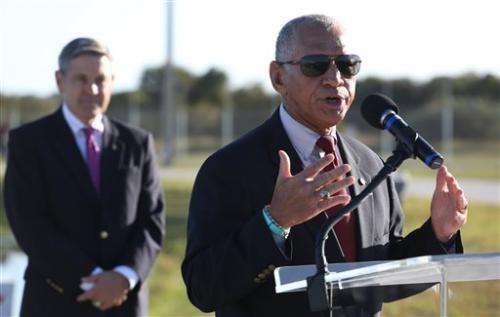
NASA administrator Charles F. Bolden Jr., right, speaks at a news conference at the Cape Canaveral Air Force Station, Wednesday, Dec. 3, 2014, in Cape Canaveral, Fla. Orion is scheduled to lift off Thursday, Dec. 4, 2014, on a United Launch Alliance Delta 4-heavy rocket on its first unmanned orbital test flight. To the left is Bob Cabana, director of the Kennedy Space Center. (AP Photo/Marta Lavandier) -
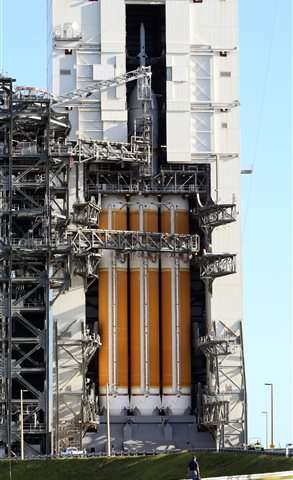
A worker walks up to the launch pad as final preparations are underway for Nasa's Orion flight test at complex 37 at the Cape Canaveral Air Force Station, Wednesday, Dec. 3, 2014 in Cape Canaveral, Fla. Orion is scheduled to lift off Thursday, Dec. 4, 2014, on a United Launch Alliance Delta 4-heavy rocket on its first unmanned orbital test flight. (AP Photo/Marta Lavandier)
More information: NASA: www.nasa.gov/orion/
Lockheed Martin: www.lockheedmartin.com/us/ssc/orion-eft1.html
© 2014 The Associated Press. All rights reserved.





















